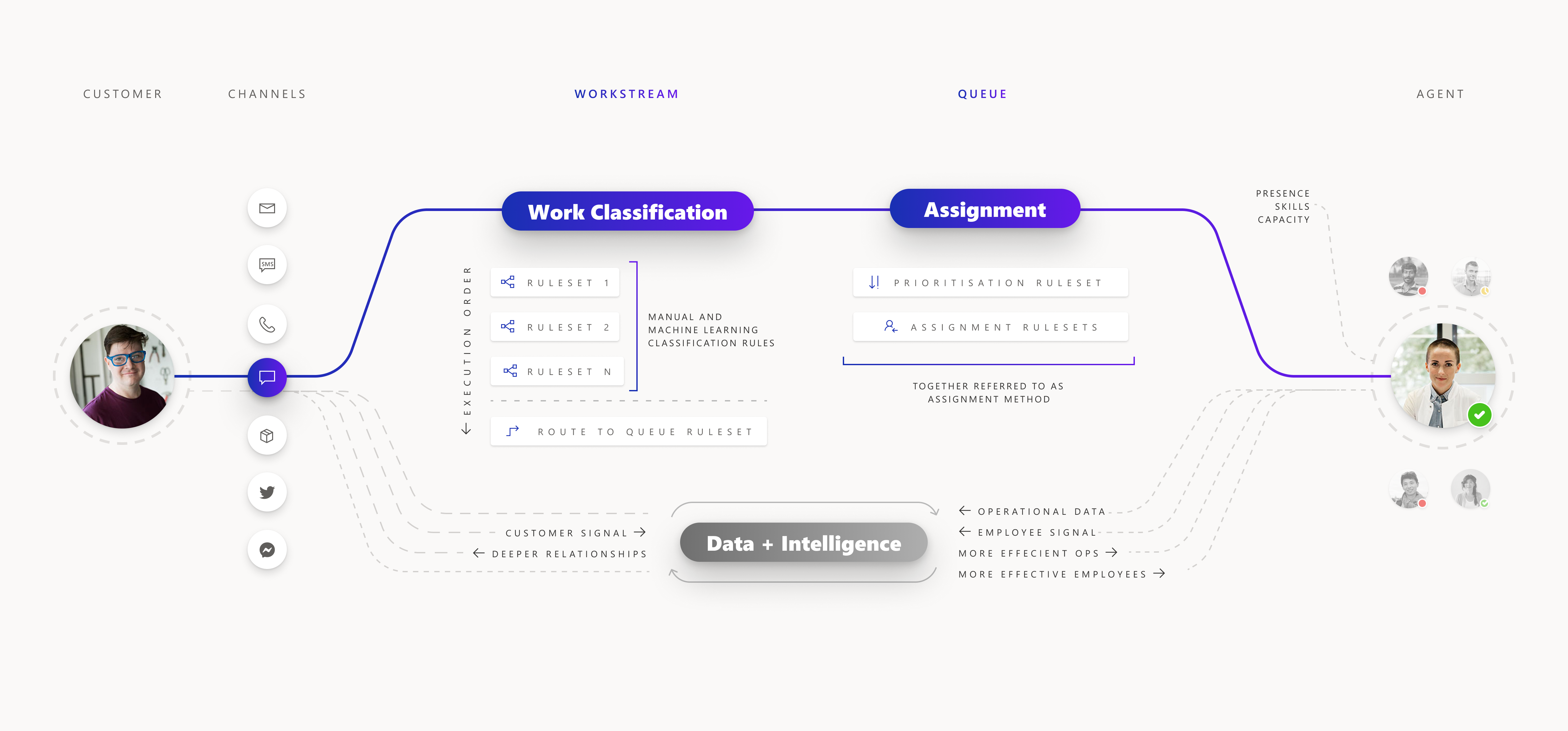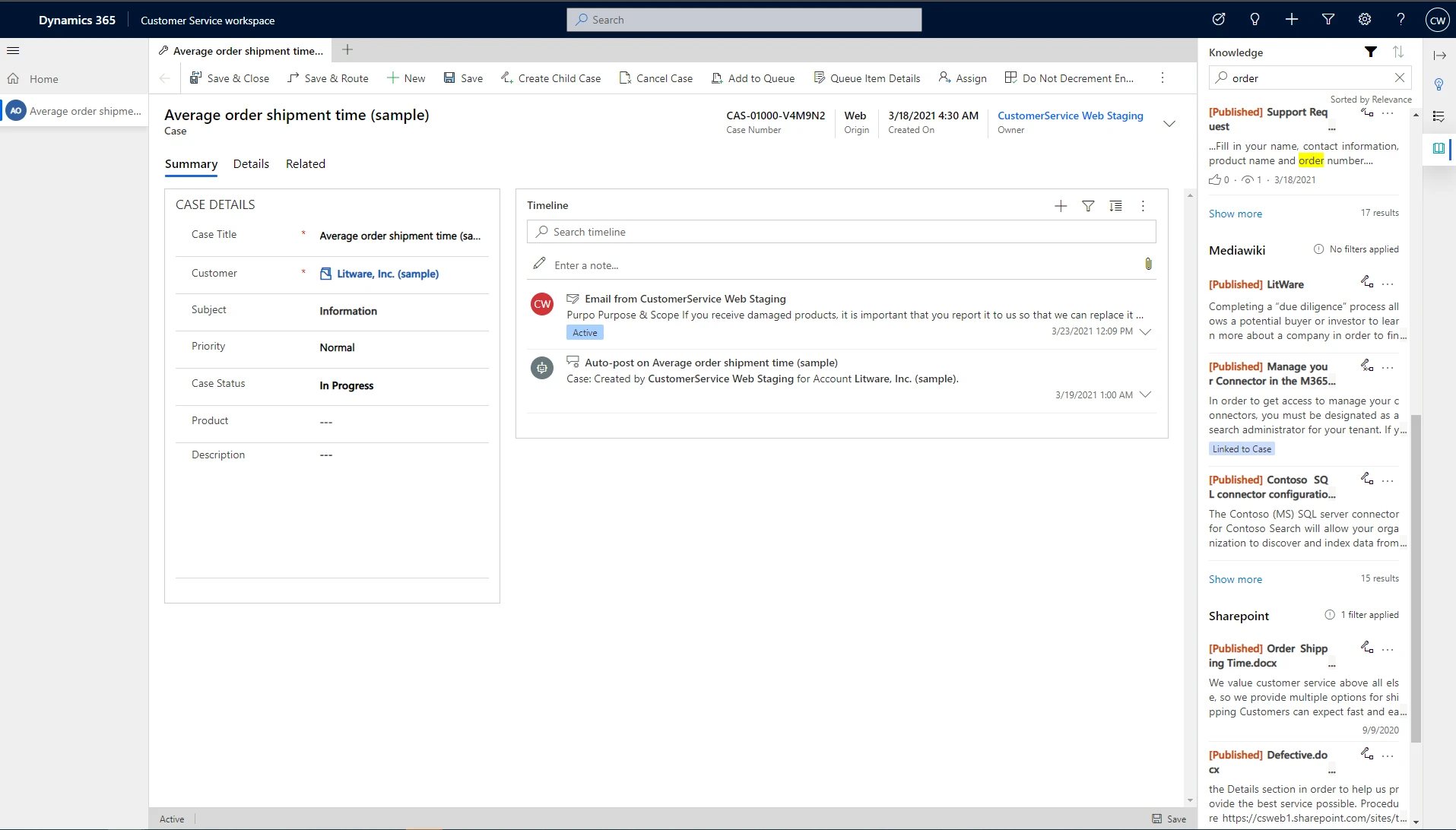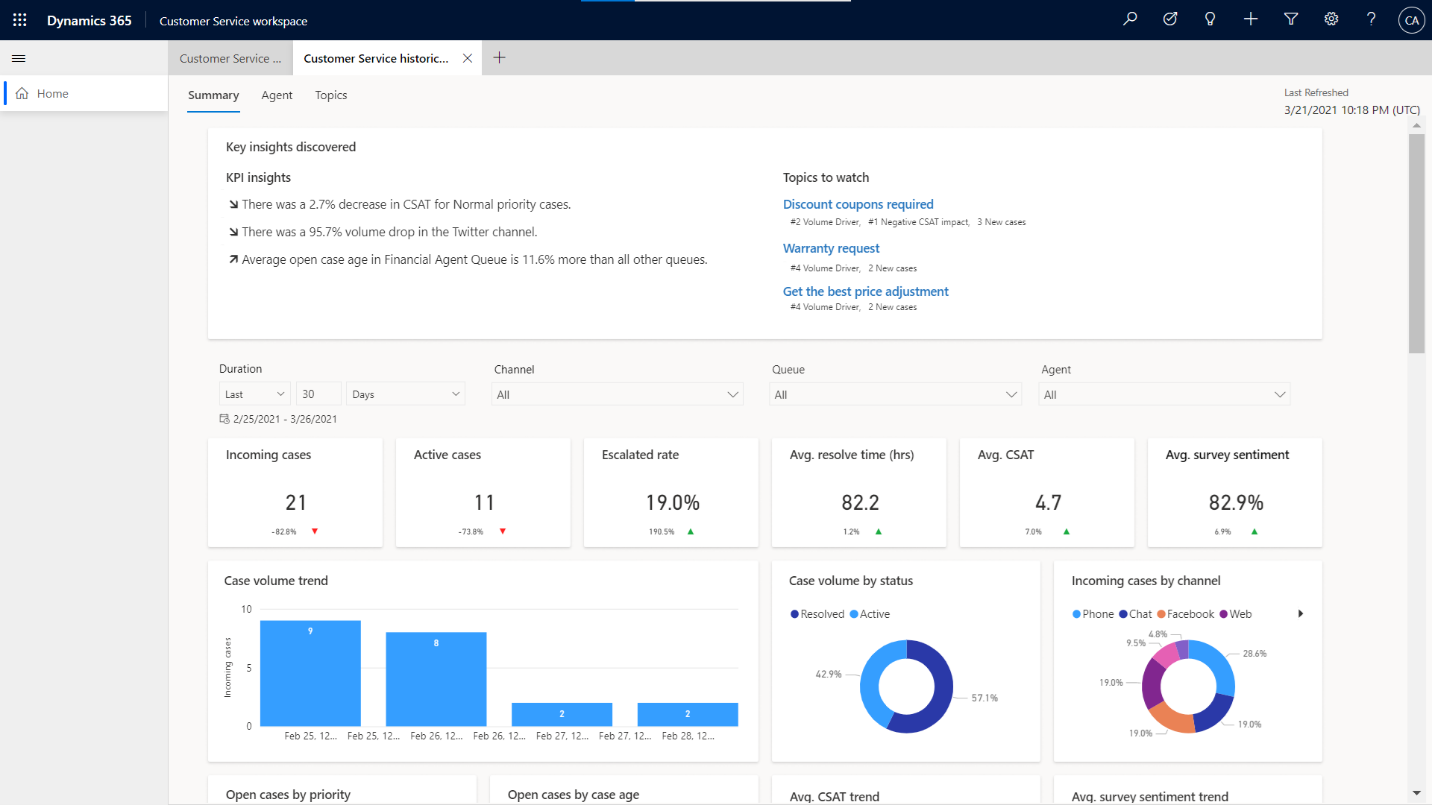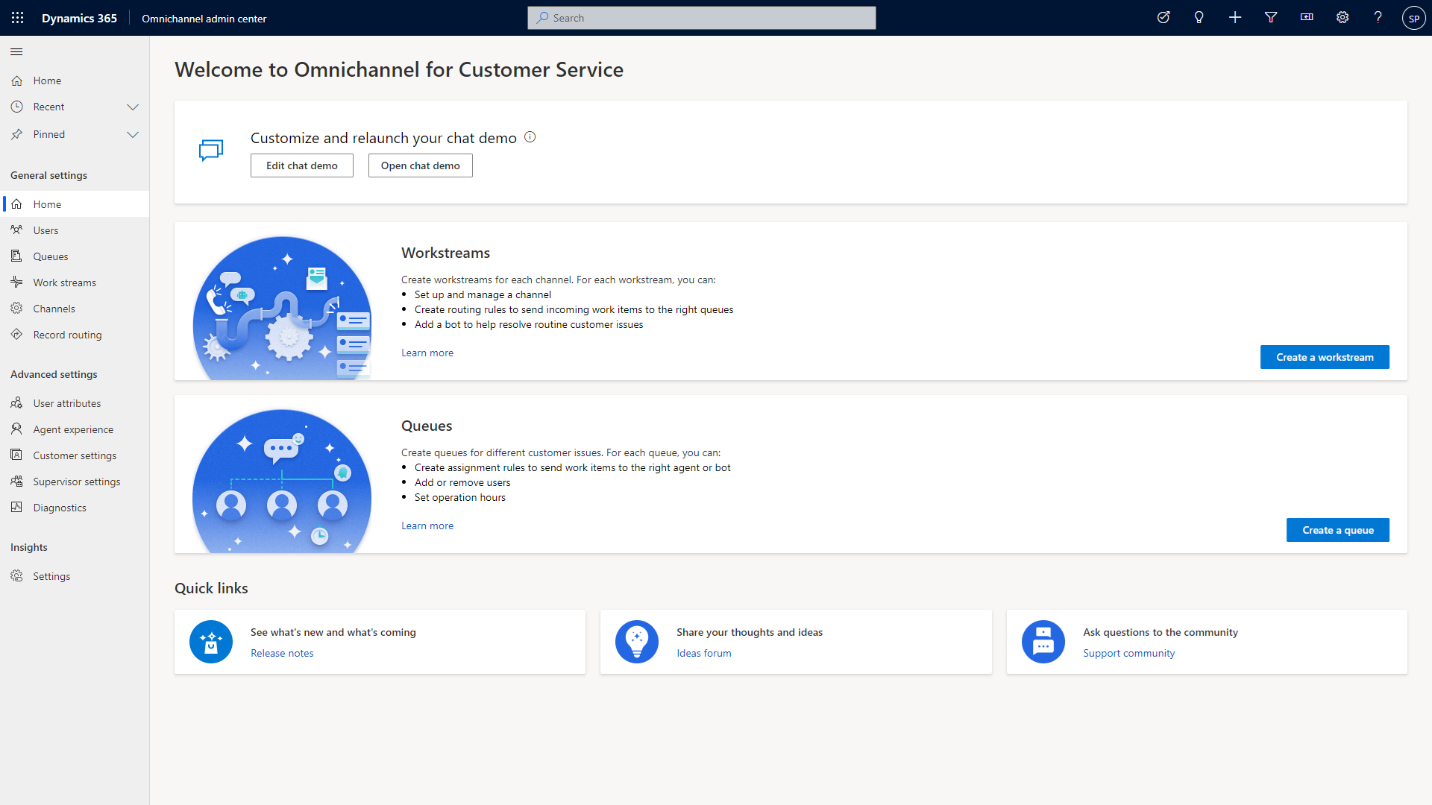
Introducing new capabilities to transform customer service and field service
Today we’re announcing new capabilities to help customer and field service teams deliver more consistent and engaging experiences, from the call center to on-site visits. The new features for Microsoft Dynamics 365 Customer Service and Microsoft Dynamics 365 Field Service provide the agility to adapt to changing customer needs, as well as streamline agent and technician workspaces, so they can resolve issues faster.
Let’s look at what’s new in this release. Be sure to review the full release notes for Dynamics 365 Customer Service and Dynamics 365 Field Service.
Dynamics 365 Customer Service
In our journey to help optimize support delivery and increase agent productivity, the following features are now generally available:
- Unified routing with modernized assignment capabilities leveraging custom rules and machine learning models to automate and scale work classification and assignment for large support organizations.
- Federated knowledge search to enable organizations to streamline and centralize the growth of their support knowledge base through other Dynamics 365 organizations, Microsoft SharePoint, and Microsoft Graph connectors.
- Embedded insights dashboards, which highlight important KPI insights for support summary KPIs, agent performance, support topic activity, and knowledge to alert supervisors to direct actions they can take to optimize support delivery every day.
- AI-powered suggestions to help agents resolve customer issues faster, and we’ve expanded these capabilities to support non-English languages.
- Streamlined, simplified set up for omnichannel through a new administrative experience.
Intelligent work classification and assignment with unified routing
Many people are involved in monitoring support queues to ensure incoming customer requests are properly classified in the right queues and assigned to available agents. This time-consuming activity can slow customer issue resolution and impact customer satisfaction. With unified routing, organizations can author custom rules, create and apply machine learning models to analyze incoming customer requests, and automatically classify the issue to better match the best available agent. Corresponding assignment rules can also be created with custom rules to analyze the classified issues and choose the best available agent to handle the issue based on the agent’s skills, spoken language, product expertise, or other attributes. Unified routing eliminates the need for constant queue supervision and manual work distribution. Agents can resolve issues faster when their strongest skills are being leveraged. This ensures customer issues are handled as quickly as possible by the best available agent resulting in increased customer satisfaction and customer retention.

Expanding your knowledge base with federated knowledge search and knowledge insights
Knowledge is something that most organizations have developed over time and it often resides in many different tools. This can make centralizing knowledge and making it easily accessible through a single interface costly and challenging. With federated knowledge search, organizations using Dynamics 365 Customer Service can enable agents to retrieve search results within multiple Microsoft Dataverse environments, SharePoint sites, and Microsoft Graph connectors through a single search interface in the agent productivity pane. Agents can deliver faster, more comprehensive service, knowing they have all the knowledge at their fingertips without having to browse disparate sets of information.
Knowledge insights dashboards also help supervisors discover the topics agents are searching for most that lack sufficient knowledge article support. Supervisors can then take action to increase and improve the knowledge base for those topics.
Read additional details about how you can increase agent efficiency with knowledge management enhancements from the 2021 release wave 1 updates for Dynamics 365 Customer Service.

Optimizing service delivery with insights
Analyzing support reports and deriving actionable insights can consume much of the supervisor’s time, reducing the amount of time to coach agents to support customers. With the latest insights dashboards, supervisors can quickly see what insights require action to drive improvement in customer sentiment, satisfaction, and speed of support delivery.
The embedded summary dashboard surfaces key insights, showing supervisors what’s driving the trend in customer satisfaction, channel volumes, queue volumes, handle time, and other KPIs. Also surfaced are support topics to watch based on key KPIs that may require automation through virtual agents or additional knowledge articles to help agents indicate product-related issues.
Agent dashboards provide deep agent analytics and important KPIs like active cases, resolved cases, customer satisfaction score (CSAT), and customer sentiment. Supervisors can drill down to specific agents to determine what action is needed, such as reducing or increasing their capacity, adjusting their skills and queue assignments, providing additional training, or coaching them on soft skills to improve customer sentiment.
Topic dashboards show how AI-generated support topics are impacting KPIs and provide the ability to drill into individual topics and acts, such as adding knowledge articles or automating the topic to a Microsoft Power Virtual Agents bot through a seamless authoring flow.
And finally, conversation insights help supervisors monitor customer issues across channels in a single dashboard where they can optimize support delivery by tracking metrics, such as wait time, abandoned conversations, and time to resolution, either at the ecosystem view or by channel.

Increasing agent productivity with improvements to smart assistance
In traditional contact centers, agents spend time searching for similar cases and knowledge articles that are relevant to the current issue they are working on. This delays resolution time and can cause decreased customer satisfaction. AI-driven suggestions help agents share the best-suited information by using the current case or conversation context and scanning thousands of cases and articles to suggest those that are the most relevant. We’re expanding AI-powered suggestions to now support non-English languages such as French, German, Spanish, Italian, Dutch, and Japanese.

Streamlining setup and configuration in omnichannel
Our new administrator experience for omnichannel makes configuring channels, such as adding Power Virtual Agents and Microsoft Dynamics 365 Customer Voice surveys, and configuring unified routing streamlined and easy. You can also experiment with live chat through a demo and test out your own configuration changes without having to implement them in an environment.

Check out what’s coming up
Microsoft Teams continues to provide powerful collaboration capabilities for businesses across organizational boundaries. In June, we will be releasing Teams integrated into Customer Service Hub for agents to be able to seamlessly reach out to other colleagues and subject matter experts for advice and assistance while helping customers from the Dynamics 365 Customer Service Hub agent experience. Agents can easily associate chats to records and visually differentiate Teams chats for faster discoverability.

In August, our first-party voice solution built on Azure Communication Services will be generally available. We are excited to offer a truly all-in-one experience with our first-party voice channel. Learn more about how the new voice channel streamlines omnichannel customer experiences.
Dynamics 365 Field Service
As we continue to enable customers to transform their service experience, the following features are now generally available:
- Technician tracking enables customers to more effectively plan around their service visits.
- Streamlined onboarding experience for faster time-to-value and ability to use Dynamics 365 Field Service in productive environments.
- Empowering technicians with knowledge management in Dynamics 365 Field Service mobile, capturing ad-hoc inspections, and inspections in multiple languages.
- Enabling dispatchers with enhanced scheduling experience, including a map, and weekly and monthly views. Plus, view appointments from other sources included in the scheduling experience.
Technician tracking for greater appointment accuracy
With the ability to view the technician’s location on a map, customers can plan around the visit and be ready when the technician arrives. This can decrease overall service delivery time and eliminate trips that might otherwise be canceled, and increase customer satisfaction with the efficient use of their time.

Streamlining setup for Dynamics 365 Field Service administrators
To ensure field service app administrators can quickly get started with Dynamics 365 Field Service, we’re introducing a simplified experience. From this improved getting started experience, you can provision your frontline workers, service accounts, and create and schedule work orders. Additionally, we provide inline access to our Dynamics 365 Field Service documentation, release plans, community, and ideas forum in the event you want to learn more, view upcoming feature work, or submit product ideas.

Empowering technicians with enhanced knowledge and inspections
Knowledge management is now embedded in the Dynamics 365 Field Service mobile app to better service assets and resolve issues even without the internet. By embedding knowledge management into field service processes in the mobile app, technicians can more reliably resolve work orders and install assets the first time, reducing costs by avoiding follow-up visits. Technicians can also author and link knowledge articles to work orders, enabling knowledge sharing to help other technicians with the same issue on future visits.


Capturing inspections while on the job is essential for many field service technician scenarios. In some situations, the inspection is required when the work order is created. However, in other situations, technicians need the option to do an “ad-hoc” inspection for a customer which was not specified in the work order. Technicians can now select and complete an inspection from the list of inspections relating to a customer asset, regardless of whether it is specified on a work order. In addition, inspections are now available to be viewed and completed based on the preferred language of the technician.

Enabling dispatchers with a rich scheduling experience
Having a single view with all relevant information is key for dispatchers to safeguard that customer commitments are being met while ensuring technicians are scheduled effectively. The new scheduling experience (introduced during last year’s release wave 2) has been enhanced to now include a map view that shows work and technicians by location. The experience now also includes multi-day scheduling for work which spans across multiple days.
Another challenge for dispatchers is having visibility into other appointments, such as those on a technician’s Microsoft Outlook calendar, which needs to be considered when determining availability. In addition to typical bookings, the scheduling experience now provides visibility into appointments from other calendars.
These enhancements enable the dispatcher to have a comprehensive scheduling view and ensure optimal scheduling in a single experience.

Check out what’s in preview and what’s coming up
Be sure to enable “preview” on your organization and check out the portal for customers to manage appointment scheduling. When organizations are solely responsible for scheduling field service visits, customers often must wait for contact centers to reach out to schedule and update them on their field service appointments. This process can cause frustration, decrease customer satisfaction, and increase back-office overhead.
To empower customers with flexibility and transparency to schedule, adjust, and monitor their field service visits, we’re introducing a self-service portal. Through the portal, customers can schedule their service appointments, view upcoming appointments, receive reminders, and track their technician’s location while en route to the visit. Giving customers the ability to manage their service appointments can help reduce scheduling errors and rescheduling of appointments. This has the added benefit of reducing your organization’s back-office costs by decreasing scheduling call volume and freeing up team members to focus on delivering quality service.

In June, we’ll launch the preview of embedded Teams collaboration, which allows users to collaborate within the Microsoft Dynamics 365 workspace and link conversations to work orders. With this embedded functionality, all stakeholders involved in the service process can collaborate through Teams with full context. Dispatchers, asset managers, and other field service stakeholders can link existing Teams conversations or initiate new conversations, such as informing the scheduled technician of added information about the service. If your organization allows for Teams collaboration with customers, they can collaborate on work orders, too.
We are honored to continue supporting you on your journey to deliver amazing service and earn customers for life. We look forward to continued engagement and your feedback on these new features and continuing to deliver the capabilities you need to enable great service delivery in your organization.
Learn more
- Read more about the April 2021 release wave 1, and how Dynamics 365 Customer Service transforms the contact center and the new Dynamics 365 Field Service customer empowering features.
- Review the October 2020 release wave 2 for Dynamics 365 Customer Service and Dynamics 365 Field Service.
- Sign up for a free trial of Dynamics 365 Customer Service.



